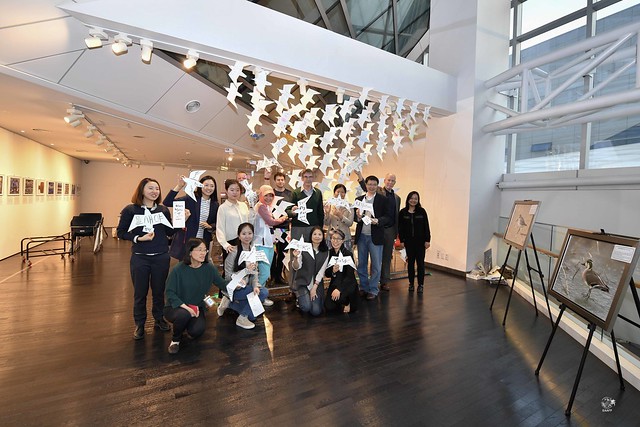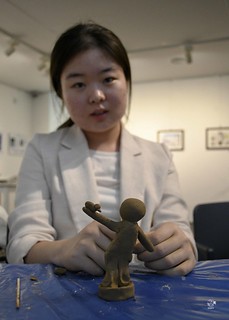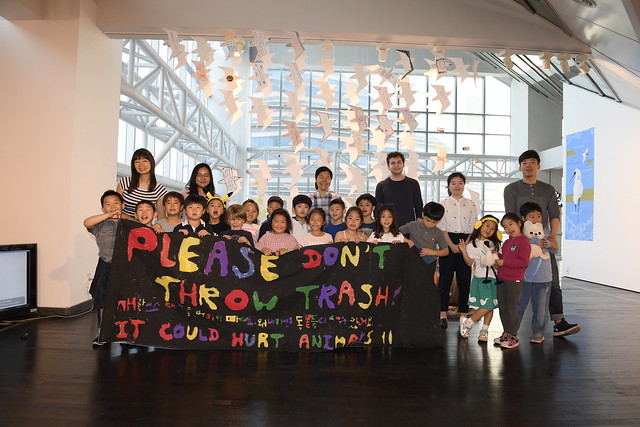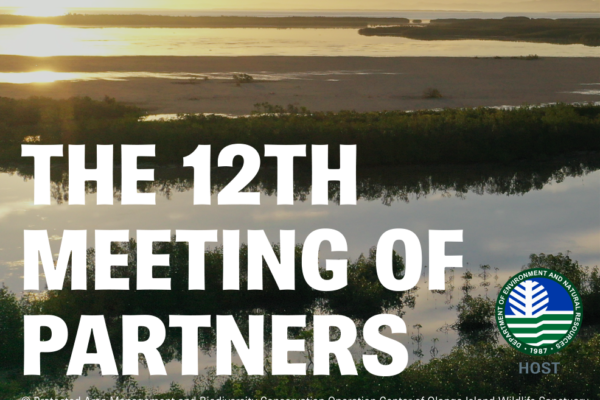
Ga-on Lee, Senior intern, EAAFP Secretariat
After several months of preparation, our World Migratory Bird Day (WMBD) event is nearing the end. I was fully involved in the preparation to promote the event through the East Asian-Australasian Flyway, and also lead the local event in the G-Tower in Incheon, the Republic of Korea. I would like to report about this local event where we held an exhibition, a participatory art program, and presentations by experts in the field. With support from experts and the local community, the event became very colorful and lively. This year, I believe this year’s event more than any other year both helped the public feel involved and awakened to the amazing journeys of our migratory waterbirds.
For the exhibition in G-Tower, we presented Red Knot artworks made by Janet Essley. It was one of my jobs to prepare translations of the captions in order to help local people understand the story behind each picture. While translating the captions into Korean, I was able to learn several things about the Red Knots’ journey. First, I realized what a demanding journey they are undertaking from Australia and New Zealand all the way through South Asia and the Yellow Sea to Arctic Russia. Impressively, they only need to take a few stops during their incredibly long journeys. Even more impressive, this journey is not a one-time event in their lives; they must repeat the trip every year. Second, it was amazing that the birds must undergo an incredible physical transformation in order to complete their journeys. For example, Red Knots will reduce the size of their inner organs to make space for the increased fat reserves they will need for their flights. The stopover sites along their journey were the most appropriate sites for feeding due to an abundant supply of prey. Every behavior these birds exhibit is strategically important to successfully complete their journey.
Moreover, we held two special events: one at the opening day of the exhibition, and the other on World Migratory Bird Day. Thanks to Spike Millington, the Chief Executive of EAAFP, and Ms. Aeran Kim, the owner of Cafe JARB in G-Tower who helped coordinate the event, there were many guests from G-tower and the local community. We were happy to teach people about WMBD and our conservation efforts to save the birds. Mr. Spike Millington introduced some birds like the Bar-tailed Godwit. They seemed both sympathetic with the threats the birds are facing and enthralled by the amazing flying ability of migratory birds. Mr. Jim Harris, Senior Vice President of the International Crane Foundation, gave a talk about crane conservation activities in the Flyway. I believe those valuable talks from Spike and Jim did much to leave an impression on the attendees about both the efforts that people living throughout the flyway are undergoing to protect migratory waterbirds, and also the further steps that are still needed in order to ensure the continued survival of these magnificent creatures.
Unlike previous years, this year we invited a calligr apher and a clay artist to the events. At the first event, the calligrapher, Ms. Lucia Choi, gave a short lecture about how to express our emotions with a brush. With her energetic and interesting explanations, participants quickly became immersed in the activity. Luckily, I also had the opportunity to participate in the class. It was a good chance for me to express the thoughts and emotions that I wanted to send to the migratory waterbirds and also share them with others. In the second special event, an honored mastery artist of green celadon, Gap-Yong Kim, led a clay art workshop. Each participant was provided with clay in order to utilize their own creativity to make something that was uniquely theirs. There were several interesting creations, such as Black-faced Spoonbills, shorebirds, and even a couple popular cartoon characters. For me, I made a miniature version of myself with a bird perched on one of my arms. Regardless of what each of us made, somehow it felt like touching the mud connected us to the migratory waterbirds. Most recently, a group of students from a local school visited us with their handmade banner to raise awareness about keeping the waterbird habitats clean and safe.
apher and a clay artist to the events. At the first event, the calligrapher, Ms. Lucia Choi, gave a short lecture about how to express our emotions with a brush. With her energetic and interesting explanations, participants quickly became immersed in the activity. Luckily, I also had the opportunity to participate in the class. It was a good chance for me to express the thoughts and emotions that I wanted to send to the migratory waterbirds and also share them with others. In the second special event, an honored mastery artist of green celadon, Gap-Yong Kim, led a clay art workshop. Each participant was provided with clay in order to utilize their own creativity to make something that was uniquely theirs. There were several interesting creations, such as Black-faced Spoonbills, shorebirds, and even a couple popular cartoon characters. For me, I made a miniature version of myself with a bird perched on one of my arms. Regardless of what each of us made, somehow it felt like touching the mud connected us to the migratory waterbirds. Most recently, a group of students from a local school visited us with their handmade banner to raise awareness about keeping the waterbird habitats clean and safe.
 Even though preparing for the events was not easy, it was my pleasure to coordinate the events with many people. I hope our Secretariat was able to work as a channel for the local people to raise the awareness of WMBD. I also want to thank the other interns, Viktoriya, Clinton, and Minjae, who have been working hard to prepare every single thing for the events, as well as maintaining the exhibition every day. I believe these kinds of celebrations for World Migratory Bird Day at the local level are very meaningful, and I hope more and more events will be held throughout the Flyway.
Even though preparing for the events was not easy, it was my pleasure to coordinate the events with many people. I hope our Secretariat was able to work as a channel for the local people to raise the awareness of WMBD. I also want to thank the other interns, Viktoriya, Clinton, and Minjae, who have been working hard to prepare every single thing for the events, as well as maintaining the exhibition every day. I believe these kinds of celebrations for World Migratory Bird Day at the local level are very meaningful, and I hope more and more events will be held throughout the Flyway.
Relevant links
- WMBD 2017: Red Knot artwork exhibition and TOWT (21 Apr-29 May) (Flickr)
- WMBD 2017 Celebration (Flickr)




